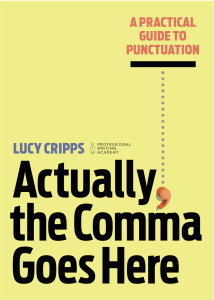Commas and independent clauses
Commas drive me crazy. I’m often unsure about whether my clients’ long sentences need commas. A helpful rule is finally sinking into my head. I need to place a comma before an independent clause that follows a coordinating conjunction.
What’s an independent clause?
 Here’s a nice, informative example from Actually, the Comma Goes Here by Lucy Cripps:
Here’s a nice, informative example from Actually, the Comma Goes Here by Lucy Cripps:
Each independent clause makes sense on its own, but it links very closely in theme to the other independent clause.
In the example, the phrases before and after the comma are each independent clauses.
“But” is bolded in the example to point to the importance of coordinating conjunctions like it in connecting independent clauses.
What’s a coordinating conjunction?
A coordinating conjunction—sometimes known as a coordinate conjunction— connects “elements of equal rank” in a sentence, in contrast with a subordinating conjunction that introduces “a subordinate element,” according to Words into Type.
A mnemonic—memory aid—can help you remember the main coordinating conjunctions. It’s FANBOYS.
For
And
Nor
But
Or
Yet
So
Some people, like Erin Brenner in “The Trouble with FANBOYS” quibble about the rules for FANBOYS, I think the mnemonic remains useful as a reminder that a comma may be needed.
What if there’s a dependent clause?
Can you skip commas if a sentence consists of an independent and a dependent clause? It depends.
The following example from Actually, the Comma Goes Here both illustrates and explains the rule for when to use commas when combining an independent and a dependent clause:
If the dependent clause comes before the independent clause, we add a comma after the dependent clause.
Don’t use a comma if the dependent clause follows the independent clause.
Disclosure: If you click on an Amazon link in this post and then buy something, I will receive a small commission. I provide links to books only when I believe they have value for my readers.
